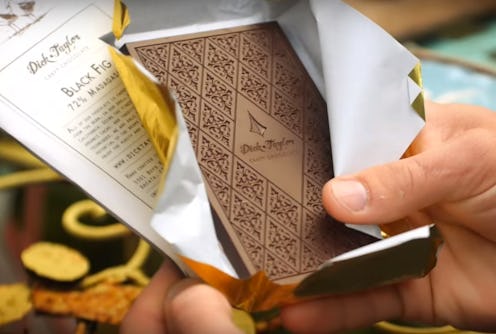Life
This Is How Chocolate Labels Get Made

The growing trend toward artisanal chocolate has many people approaching the substance the same way they do wine — as something to be tasted carefully and appreciated for its subtleties. There’s another way that craft chocolate mimics wine: Most of us don’t know how to choose it, so we do the logical thing and grab the bottle — or bar — with the coolest label. That may not be the right way to select chocolate, but, come on, you know that's how it usually goes. Craft chocolate makers are fully aware of just how easily we're swayed by beautiful chocolate packaging, and have taken to dressing their wares in increasingly lush wrapping. In a recent feature for Chocolate Noise , a digital project exploring the world of craft chocolate, food writer Megan Giller (who also happens to be a friend of mine) sat down with one artisanal chocolate maker to get the scoop on how they design and create their distinctive — and mouthwateringly pretty — labels.
Giller interviewed Adam Dick and Dustin Taylor, the founders of Dick Taylor, a California craft chocolate company known for it’s particularly fine packaging. Taylor explained that when he and Dick started working on their wrappers, other bars were looking fairly homogenous, with the majority wrapped in brown paper and featuring cacao pods or Mayan-themed images. They chose “to do everything exactly the opposite of that.” With inspirations ranging from wood shavings to argyle socks, the pair finally chose to go with a nautical theme, with old-fashioned images of boats dominating the labels. Knowing that nautical things are trendy at the moment, Dick and Taylor were careful to avoid anchors, as well as that other hipster standby, mustaches.
The craft chocolate movement tends to do things the hard way by emphasizing old-school methods, small batches, and a lot of hands-on work. Dick Taylor’s packaging is no different, letterpress printed by hand using 12 thousand pounds of printing equipment brought in from Oakland. Dick and Taylor also spent a lot of time ensuring that the chocolate itself is as beautiful as its packaging. Each bar has been pressed with an intricate pattern of diamonds and curls, a process that initially took ages to perfect, as the chocolate had to be retempered over and over to work with the molds.
Compared to mass-produced chocolate, craft chocolate bars don't come cheaply, which is one reason that having memorable packaging is so important for makers. The graphic designer who created Dick Taylor’s look, Dustin’s brother Garrett, explained,
The shape of the package, the thickness of the paper, the feel like it’s worth the $8 or $9 that you spent on it. It’s almost like when you buy like a Mac product, like a new iPhone or iPad. There’s something to the packaging—It’s just a few simple elements that make it feel like whatever is inside is high quality.
Giller told me that Dick Taylor isn’t the only company paying attention to aesthetics, saying, “Up until the past year or so, most craft chocolate makers haven't paid that much attention to their packaging. Now almost everyone is redoing their labels and designs to make them more appealing and interesting, and to express their individual point of view.”
Scroll through for eight of the most beautiful chocolate bars on the market, as well as advice on how to choose bars that taste as good as they look. Chocolate wrapped in “beautiful handmade paper” is particularly trendy these days, Giller says, a fact borne out by many of these gorgeous bars. Seriously, you’re going to find yourself having a hard time tearing the packaging from these beauties:
Mast Bros.
Mast Bros., $9
Mast Bros. is a New York-based bean-to-bar chocolate maker that's well known for it's bold, graphic wrappers.
Marou
Bean to Bar Chocolate, $8.37
Marou is an artisanal chocolate maker based in Vietnam. I want to wallpaper my apartment with this metallic paper. I'm not even kidding.
Cacao Prieto
Cacao Prieto, $8.00
Cacao Prieto sources all of its beans from the Dominican Republic. It's bars are all covered in gorgeous, colorful drawings.
Dick Taylor
Dick Taylor, $8.50
While many companies go for abstract designs, Dick Taylor goes a more narrative route, with letterpressed images of boatbuilding and sailboats.
Raaka
Raaka, $7.95
Raaka's simple black and white drawings make theirs some of the most elegant bars on the block.
Rogue
Rogue, $18
Massachusetts chocolate company Rogue takes a modern, minimalist approach.
Dandelion Chocolate
The wrapping from this San Francisco-based company features pretty, subtle metallics.
Compartés
Compartés, $9.95
L.A. based Compartés offers technicolor packaging and adventurous flavors (including dark chocolate with kale and "cereal bowl").
BUT WAIT! How do I make sure my chocolate is more than a pretty face?
As seductive as gorgeous packaging can be, what we really want in life is great chocolate. Fortunately, the labels on craft chocolate bars can tell you more than “Hey, I’m pretty!” Before buying chocolate, Giller suggests you look for a few key bits of information on the package: First, check for the phrase “bean to bar” or the names of individual countries (such as Madagascar or the Dominican Republic). She explains that these labels “show that the makers are actually buying beans themselves and roasting, grinding, and shaping them into chocolate instead of just melting down bulk chocolate and selling it as their own.” Next, look at the bar’s list of ingredients; it should be relatively short and include cacao beans, sugar, and (maybe) cacao butter. Giller warns that if it contains soy lecithin or other fats (like vegetable oil), “it's not going to be great chocolate.”
Images: YouTube (3)